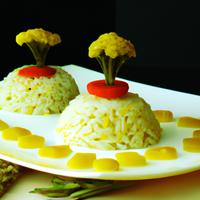
1 serving (100 grams) contains 120 calories, 2.0 grams of protein, 1.0 grams of fat, and 25.0 grams of carbohydrates.

Log this food in SnapCalorie

Nutrition Information
Calories |
240 | ||
|---|---|---|---|
% Daily Value* |
|||
| Total Fat | 2 g | 2% | |
| Saturated Fat | 0.4 g | 2% | |
| Polyunsaturated Fat | 0 g | ||
| Cholesterol | 0 mg | 0% | |
| Sodium | 400 mg | 17% | |
| Total Carbohydrates | 50 g | 18% | |
| Dietary Fiber | 2 g | 7% | |
| Sugars | 0 g | ||
| protein | 4 g | 8% | |
| Vitamin D | 0 mcg | 0% | |
| Calcium | 20 mg | 1% | |
| Iron | 2 mg | 11% | |
| Potassium | 60 mg | 1% | |
* Percent Daily Values are based on a 2,000 calorie diet. Your daily values may be higher or lower depending on your calorie needs.
Food Attributes
Source of Calories
About Yellow and white rice
Yellow and white rice is a vibrant dish commonly found in Latin American, South Asian, and Middle Eastern cuisines. The yellow color typically comes from spices like turmeric or saffron, offering antioxidant and anti-inflammatory benefits. White rice serves as the base, prized for its versatility and mild flavor. While white rice is a refined grain, making it lower in fiber compared to whole grains, it is a good source of carbohydrates, providing quick energy. Yellow and white rice dishes often incorporate ingredients like onions, garlic, and oils, which can enhance flavor but may add calories and fats. Pairing this dish with vegetables and lean protein can make it a well-rounded meal. Though not as nutrient-dense as brown rice, yellow and white rice remains a satisfying and approachable option for many global recipes. Moderation and mindful ingredient choices are key for maintaining its nutritional balance.



